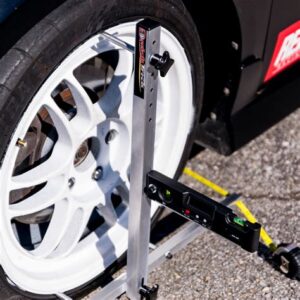Introduction
Maintaining your vehicle is essential for ensuring safety, performance, and longevity, and one critical aspect often overlooked is wheel alignment. Proper alignment not only enhances your car’s handling and efficiency but also contributes to tire longevity and overall driving comfort. In this article, we will delve into the importance of regular car alignment, discussing how frequently you should check it, the signs indicating misalignment, and the numerous benefits of adhering to a consistent alignment schedule. Whether you’re a seasoned driver or a new car owner, understanding how often you should align your car can save you time, money, and frustration on the road. Let’s explore the ins and outs of car alignment to keep your vehicle running smoothly and safely.
Understanding The Importance Of Regular Car Alignment
Regular car alignment is crucial for the overall performance and longevity of your vehicle. Proper alignment ensures that your tires wear evenly, which not only extends their life but also improves fuel efficiency. When your car is in alignment, it drives and handles better, offering a more comfortable ride for you and your passengers. This is particularly significant when considering how often you drive, as a well-aligned vehicle can enhance driving safety by providing better control, especially during turns and emergency maneuvers.
Moreover, neglected alignment can result in various mechanical problems. It can put undue stress on suspension components, leading to costly repairs down the line. Misalignment can also adversely affect your car’s braking system, making it vital to keep track of your alignment status routinely.
Incorporating regular alignment checks into your vehicle maintenance schedule can save you money in the long run and ensure your car operates at its best. A good rule of thumb is to have your alignment checked at least once a year, or more frequently if you notice any of the signs indicating that a check is necessary.
How Often Should You Check Your Car Alignment?
Understanding how often to check your car alignment is essential for maintaining your vehicle’s performance and safety. Generally, it is advisable to inspect your car’s alignment every 6,000 miles or at least once a year. However, several factors can influence this frequency:
- Driving Conditions: If you frequently drive on rough roads, uneven surfaces, or potholes, you may need to check your alignment more often.
- Vehicle Usage: If you use your vehicle for heavy-duty purposes like towing or carrying heavy loads, consider more regular checks for alignment issues.
- Seasonal Changes: Changes in weather and temperature can affect your vehicle’s suspension components. It’s good practice to check your alignment with seasonal tire changes.
- After an Incident: If your vehicle has been involved in a collision or experienced significant impact from hitting a curb or pothole, you should have your alignment checked immediately.
Regularly monitoring your vehicle’s alignment is crucial for prolonging tire life, enhancing fuel efficiency, and ensuring a smoother driving experience. Paying attention to any signs of misalignment can also help you determine when to schedule these important checks.
Signs That Indicate Your Car Needs Alignment Now
Recognizing when your car needs an alignment is crucial for maintaining its performance and longevity. Here are some key signs to look out for:
- Uneven Tire Wear: If you notice uneven wear on your tires, this can indicate alignment issues. Tires should wear evenly; if you see more wear on one side, it’s time for a check.
- Steering Wheel Misalignment: If your steering wheel is off-center when you’re driving straight, this is a clear sign that your car’s alignment needs adjustment.
- Pulling to One Side: When you let go of the steering wheel, if the vehicle drifts to one side without any input from you, it suggests that the alignment is off.
- Vibration in the Steering Wheel: Feeling a vibration or shake in the steering wheel could also indicate misalignment or other issues with your vehicle’s suspension.
- Increased Fuel Consumption: Poor alignment can cause your engine to work harder, leading to decreased fuel efficiency. If you notice a sudden change in fuel consumption, consider an alignment check.
Understanding how often you should check your car alignment can save you from more significant problems down the road. Regularly watching for these signs ensures a smoother ride and better overall vehicle health.
The Benefits Of Frequent Car Alignment Checks
Regularly checking your car’s alignment can yield several significant benefits that contribute to the overall performance and safety of your vehicle. Here are some key advantages:
- Improved Tire Longevity: A proper alignment helps in even tire wear. This means your tires will last longer, saving you money in the long run and reducing the frequency of replacements.
- Enhanced Fuel Efficiency: Misalignment can cause your vehicle to drag, leading to increased resistance and higher fuel consumption. By maintaining correct alignment, you’ll likely notice better gas mileage.
- Better Handling and Safety: Correct alignment improves handling, providing a smoother driving experience. This ensures that your car tracks straight and stable, reducing the risk of accidents.
- Reduced Strain on Suspension Components: When your wheels are properly aligned, it reduces wear on suspension parts which can protect against costly repairs and maintain the vehicle’s performance.
- Increased Driving Comfort: With proper alignment, the vehicle handles better, making for a more comfortable drive, especially on longer journeys.
Overall, understanding how often to check your car’s alignment can lead to these beneficial outcomes, ultimately enhancing your driving experience and vehicle safety.
How Often Is Too Often For Car Alignment Adjustments?
When it comes to car alignment, the question of how often is too often often arises among vehicle owners. Regular checks and adjustments are crucial for maintaining vehicle performance and safety, but there is a balance to strike. Overly frequent alignments can lead to unnecessary wear and tear on components and increased costs without substantial benefits.
Generally, it is recommended to check your vehicle’s alignment every 6,000 miles or as part of your regular maintenance schedule, such as an oil change. However, getting an alignment more frequently than every 3,000 miles can be excessive for most vehicles unless specific issues arise. Factors that might warrant more frequent alignments include:
- Driving on rough roads or over potholes
- Repetitive off-roading
- Noticeable steering issues or vibrations
- Excessive tire wear
Here’s a quick guide outlining the recommended alignment check intervals:
| Driving Conditions | Recommended Alignment Frequency |
|---|---|
| Regular driving on well-maintained roads | Every 6,000 miles |
| Frequent rough terrain or off-roading | Every 3,000 – 5,000 miles |
| Steering concerns or uneven tire wear | As needed, or immediately |
Knowing how often to get alignment adjustments can help you maintain optimal vehicle performance without incurring unnecessary costs. If you’re uncertain, always consult a professional who can assess your vehicle’s specific needs and conditions.
Frequently Asked Questions
What does aligning a car mean?
Aligning a car involves adjusting the angles of the wheels so that they are perpendicular to the ground and parallel to each other, ensuring better handling and tire wear.
How often should I get my car aligned?
It’s generally recommended to have your car aligned every 6,000 miles or during routine maintenance checks, but this can vary based on driving habits and road conditions.
What are the signs that my car needs an alignment?
Common signs include uneven tire wear, your vehicle pulling to one side, a steering wheel that is off-center, or vibrations while driving.
Can bad alignment affect fuel efficiency?
Yes, poor alignment can cause your tires to drag and create additional friction, leading to decreased fuel efficiency.
Are there different types of alignments?
Yes, the main types include front-end alignment, thrust angle alignment, and four-wheel alignment, each addressing different aspects of wheel positioning.
How much does a wheel alignment typically cost?
The cost of a wheel alignment can vary widely depending on the vehicle and location, but it generally ranges from $75 to $100.
Can I align my car myself?
While it’s possible to perform a basic alignment with specific tools, it’s often best to have it done professionally to ensure accurate adjustments.





